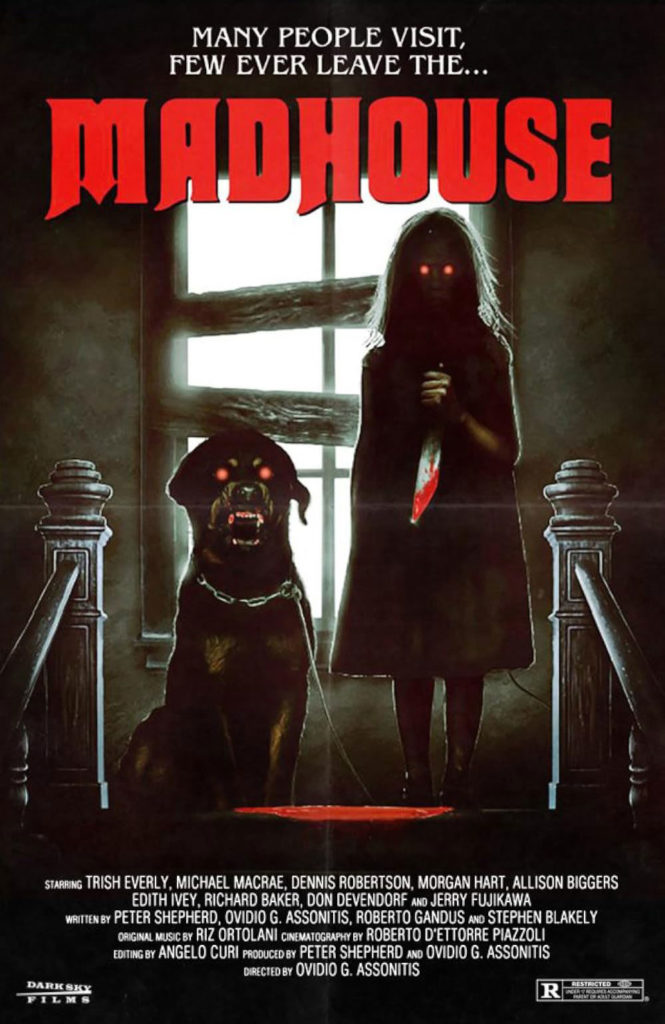New Orleans has been a popular filming location for horror flicks. Parts of that town have the patina of age and dire history that make it perfect for the genre. Don’t sleep on Savannah, Georgia, though. Its historic district is packed full of edifices built by the southern gentry of ages past, and all the baggage that implies. Just like every other American city in the 1970s and ’80s, decay and deterioration only added to the area’s horror bona fides.
Take Kehoe House, a Queen Anne mansion commissioned in the 1890s by immigrant industrialist William Kehoe. Not quite one of the Gilded Age piles that lined 5th Avenue in New York, it’s still an imposing structure that fronts an entire short block of Columbia Square. It’s a well-rated historic inn these days, but back in the early ’80s, it was rundown — close to being a wreck, and the ideal location for Madhouse, from writer, director, and producer Ovidio G. Assonitis. Writing credits were shared with Stephen Blakely, Roberto Gandus, and Peter Shepherd.
No Tentacles, this film. Madhouse, released in Italy under the title There Was a Little Girl, is a slasher, with a fair amount of psychological horror. The film follows Julia Sullivan (Patricia Mackey), a teacher at a school for the deaf who is in absolute dread of her upcoming birthday. That’s because Julia has a twin sister, Mary (Allison Biggers), who used to torment her when they were children. Mary has been in an asylum all her adult life, but demands to see Julia after being estranged for years, reopening old wounds just in time for their birthday.
Mary’s mental health isn’t the only thing that’s been deteriorating over the years. A mysterious disease has deformed her features, while Julia could be in magazine ads. This divergence has left Mary further embittered, and was also a great help to the production, as, under a bunch of prosthetic makeup, it didn’t matter that Biggers and Mackey don’t look alike.
Mary can’t help but torment Julia upon her visit, declaring that Julia will never be free. But, what can Mary really do while she is locked away and slowly succumbing to disease? She can break out like Michael Myers and rack up a body count, that’s what.
Now we’re back to Kehoe House. Julia lives in a well-maintained apartment on the first floor, while the house’s owner, Amantha Beauregard, lives in the attic. In this film’s universe, the house was the most magnificent funeral parlor in all the south, with the  Beauregards a family of well-respected funeral directors. The family is all gone, except for Amantha, and she’s nuts. She let the house fall into disrepair, but is beginning renovations. In practical terms, this meant that Assonitis and company had whole floors of decrepit rooms to play around in.
Beauregards a family of well-respected funeral directors. The family is all gone, except for Amantha, and she’s nuts. She let the house fall into disrepair, but is beginning renovations. In practical terms, this meant that Assonitis and company had whole floors of decrepit rooms to play around in.
One by one, every person associated with the house ends up either at the wrong end of a kitchen knife, or mauled to death by a rottweiler. How did Mary get ahold of such a vicious animal? That’s never answered. All we get is some exposition about how Mary had a dog when she and Julia were children, and Mary used to sic the dog on Julia. It was a silly moment of exposition that gives viewers some background, sure, but was more meant as a quasi-justification for a killer dog being in the movie. Get used to overwrought scenes of exposition, as Assonits relied on them to do the story’s heavy lifting.
That’s not what horror fans are watching for, though. We want blood. Madhouse does deliver. The effects aren’t the best, but they are extensive enough that Madhouse became one of the flicks on the original video nasties list in the UK.
When the film isn’t killing off characters or delivering hammy exposition, it’s a tense experience. Assonitis was building quite a nerve-wracking scenario for his protagonist. The only thing that throws the whole project off is a finale on Julia and Mary’s birthday that doesn’t make much sense, but was so over-the-top, in both set piece and performance, that all is forgiven. It’s here that one of the performers was let off a leash they had been straining against all film. The result elevates the film, while at the same time providing some unintentional hilarity. It’s a little strange to see a film so taught become so grindhouse at the end, but it’s not like Assonitis had been making The Silence of the Lambs up until then.
I enjoyed the entire package, despite all warps, dents, and other flaws, including some bottom of the barrel acting. Madhouse is a welcome addition to the October Horrorshow.
